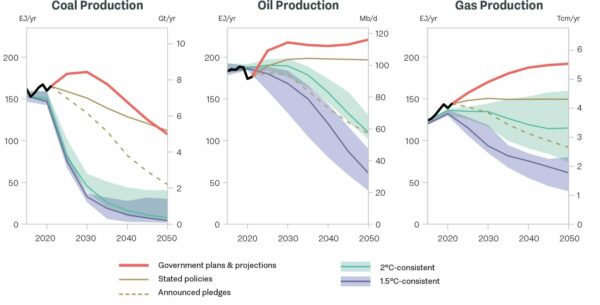Production Gap Report 2023
Authors
Ploy Achakulwisut, Michael Lazarus, Neil Grant, Céline Guivarch, Steve Pye, Roberto Schaeffer et al.

Key Findings
Governments, in aggregate, still plan to produce more than double the amount of fossil fuels in 2030 than would be consistent with limiting warming to 1.5°C. The persistence of the global production gap puts a well-managed and equitable energy transition at risk.
Taken together, government plans and projections would lead to an increase in global coal production until 2030, and in global oil and gas production until at least 2050. This conflicts with government commitments under the Paris Agreement, and clashes with expectations that global demand for coal, oil, and gas will peak within this decade even without new policies.

Major producer countries have pledged to achieve net-zero emissions and launched initiatives to reduce emissions from fossil fuel production, but none have committed to reduce coal, oil, and gas production in line with limiting warming to 1.5°C.
Governments should be more transparent in their plans, projections, and support for fossil fuel production and how they align with national and international climate goals.
There is a strong need for governments to adopt near- and long-term reduction targets in fossil fuel production and use to complement other climate mitigation targets and to reduce the risks of stranded assets.
Given risks and uncertainties of carbon capture and storage and carbon dioxide removal, countries should aim for a near total phase-out of coal production and use by 2040 and a combined reduction in oil and gas production and use by three-quarters by 2050 from 2020 levels, at a minimum. The potential failure of these measures to develop at scale calls for an even more rapid global phase-out of all fossil fuels.
An equitable transition away from fossil fuel production must recognise countries’ differentiated responsibilities and capabilities. Governments with greater transition capacity should aim for more ambitious reductions and help finance the transition processes in countries with limited capacities.











